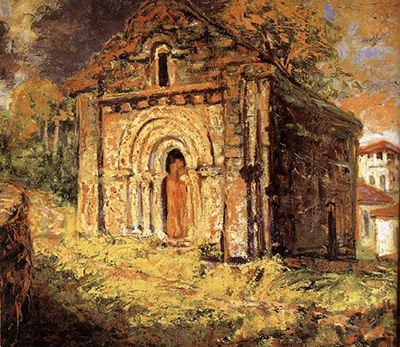Grant Wood created the Little Chapel Chancelade in 1926. The artwork is one of his many landscape genre paintings, and he used oil on canvas to create it.
The portrait is heavily painted with a palette knife resulting in an opaque layer or a thick impasto, similarly to his earlier paintings. This portrait also portrays a pastoral genre. The Little Chapel Chancelade's original piece is located at the Figge Art Museum in Davenport, Iowa.
Description of the Little Chapel Chancelade
The composition features a chapel at the centre of the portrait. The chapel has a white and brown medieval front with a brown door at the centre. The building stands in a slanting landscape, has traces of brown and green ground at the front, and a visible pathway that seems to be leading into the dense forest on the right side of the portrait. The chapel is engulfed by vegetation on one side and has a smooth transitioning of dense colours. The colours create a camouflage effect between the chapel and its scene. On the far end of the chapel's background, white buildings with brown roofing and a tiny view of blue sky are visible. The composition of the Little Chancelade landscape is placed very high, leaving a tiny viewpoint of the skyline.
Themes Depicted in the Little Chapel Chancelade by Grant Wood
The sturdiness and stillness of the chapel are conspicuous in the painting. The Little Chapel of Chancelade depicts the religious era of the painting. Besides, it displays Wood's religious encounters while on his several trips to Europe, considering that he sketched the painting in Spain. Grant Wood used an impressionism approach when painting the Little Chapel Chancelade portrait. The style is somewhat heavy-handed, with none of Monet's dissolutions of form or colour harmonies. Also, this painting style was prevalent in his other works before he made several study trips to Europe, where he learnt many other painting styles, including post-impressionism. Flemish artist Jan Van Eyck influenced Grant Wood to clarify the impressionism technique and incorporate it.
The Inspiration and Scene of the Little Chapel Chancelade
Wood started creating the Little Chapel Chancelade while on a trip to Europe, and the artwork's inspiration is still unclear up to date. Additionally, the location of this artwork scene is not established, and there was speculation that it was either in Spain or France. According to notes written by Nan Wood Graham, Grant Wood's sister, one of Grant's fellow students and friend was schooling at Académie Julian and living in a castle in Spain. Grant Wood sketched the Little Chapel Chancelade when his friend invited him to visit.




